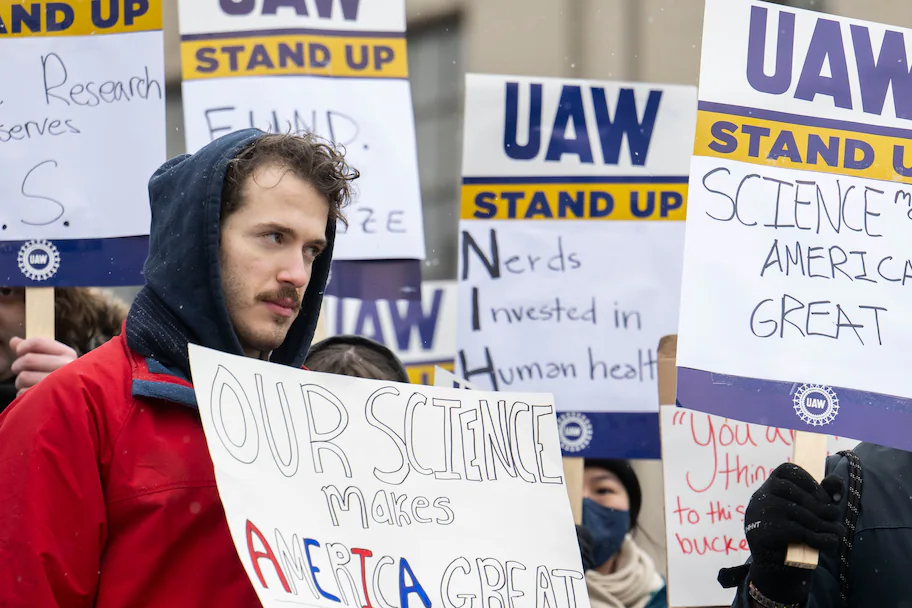Vaughn Cooper, a microbiologist at the University of Pittsburgh School of Medicine, was elated last October when his proposal to study the microbes that colonize catheters received an outstanding score from a panel of experts convened by the National Institutes of Health. Cooper and his collaborator, Chelsie Armbruster at the University of Buffalo, hoped to improve treatments for people, particularly the elderly, who develop urinary tract infections after prolonged catheter use.
A high score from the expert panel meant their grant application was almost certain to be funded by NIH.
But then Donald Trump returned to the White House, and following a rash of executive orders, Cooper is today in the same position as thousands of scientists across the country: stymied, uncertain, on hold.
NIH advisers have been unable to meet and recommend funding for research grants like Cooper’s because the Trump administration has blocked the agency’s ability to announce meetings in the Federal Register, despite a judge’s temporary ruling that ordered resumption of funding. Such Federal Register notices are required before these advisory councils can meet or reschedule.
“This really feels like an evil way of using bureaucracy against the process of science, to the contrary of what they say they are doing — streamlining bureaucracy,” Cooper said.
Biomedical research in America hasn’t been halted outright. But the Trump administration’s interference with the most routine operations of the world’s premier funder of that work has gummed up the system for selecting and funding new science projects.
From Jan. 20 to Feb. 14, NIH funding sent to outside investigators lagged behind grants for the same period last year by about $1 billion, according to an NIH database. Existing research is still being funded, but future science — research awards that would have been made in the coming months — is stuck in the pipeline. Scientists running research teams expect even less money as the administration aggressively downsizes the government. Some are preparing for layoffs and accepting fewer students into their laboratories.
“The discoveries that aren’t made — you can’t point to them, because they will never be made,” said Jeremy Berg, a former director of the National Institute of General Medical Sciences. “The hard part is you don’t know what you missed until years later, when something doesn’t happen.”
NIH and HHS did not respond to questions about when the pause on posting Federal Register notices may be lifted or why they are being blocked.
Cooper, the microbiologist, still hopes his grant might be funded this summer, but losing six months is a major blow to his laboratory, his collaborator’s in Buffalo and the technicians who work in both locations. Federally funded science supports thousands of labs that operate a bit like small businesses.
They are located within universities and medical schools and are often run by professors who rely almost entirely on grants, or “soft money.” Since World War II, the federal government has played an outsize role in funding such research, a powerful engine for developing new technologies, medicines and fundamental discoveries that have helped turn the United States into the world’s most prosperous nation.
The cancellations of obscure councils and study sections critical to moving science funding forward aren’t just a momentary setback, scientists say. Effects could reverberate for years.
Last week, 42 study sections and panels — meetings where experts in a field review each grant’s merit — were canceled, according to an NIH website. The next step, often a few months later, is an advisory council, which recommends which proposals should be funded. Those meetings are also being canceled.
Even a six-month delay in receiving grant money may mean graduate students don’t find jobs, a line of research is put on pause, or labs have to lay off skilled technicians. Some labs could even shut altogether.
The “missing” discoveries, researchers said, might include a fundamental insight into the biology of Parkinson’s disease that leads to new treatments. Or a method of screening for breast cancer that saves lives. Or an insight into basic cell biology that eventually inspires scientists to conduct experiments they can’t even imagine today.
The firings of many newly hired “probationary” workers at government agencies such as NIH and the National Science Foundation, which lost 10 percent of its staff, have disrupted the complex process by which agencies award new grants. Speaking on the condition of anonymity for fear of retribution, the staffers who remain report that they are anxious, demoralized and struggling to redistribute tasks to a smaller staff.
NIH receives about 80,000 grant applications per year. Through a rigorous review process, the agency typically selects about the top fifth for funding. Those grants often last four to five years.
The Trump administration has in just a few weeks dynamited that system.
“Unless some kind of a miracle happens and there’s a dramatic reversal over the next week or two, I think we’ll see major disruptions at universities in the next few months,” said a person familiar with the grant process, who spoke on the condition of anonymity out of fear of retaliation.
Beyond the immediate effects of these policies — people out of jobs, projects halted, internships canceled, new graduate student admissions reduced — are the long-term consequences of what could be a historic downsizing of federal investment in science.
Already-funded programs appear to be proceeding apace, but the administration’s drastic and sudden actions could imperil the aspirational side of science. That ranges from recruiting young researchers and engineers to building cutting-edge laboratories.
Bita Moghaddam, a behavioral scientist at Oregon Health & Science University, was scheduled to serve on a study section Thursday that focused on scientific grants that explore the brain mechanisms behind learning, memory and decision-making, which are often disrupted in diseases such as addiction, bipolar disorder and Alzheimer’s disease.
The study sections are the first round of expert review of new science proposed in grant applications. An email obtained by The Post written by an NIH scientific review officer who runs those meetings explained that a study section in March was being canceled because the agency is required by law to publish notice of the meetings in the Federal Register, and the notice has not been published.
“Things aren’t going to get slowed down for six months — they may get slowed down for years,” Moghaddam said. “It’s not like you’re working on a car and you can stop working on the car and return to it. Science is a process. Experiments are a process. If you halt it, you cannot just start and resume.”
The uncertainty is already affecting not only the projects planned for the future, but the next generation of scientists.
“I was prepared for some challenges, because I think it was pretty likely that Trump would cut the NIH budget,” said Jennifer Unger, a professor of population and public health sciences at the University of Southern California. “I wasn’t prepared for this level of chaos.”
Her program normally admits about 10 PhD candidates a year. This year, with budget cuts looming, it will probably admit only four, she said
The University of North Carolina at Chapel Hill will accept 25 percent fewer graduate students into one of its biomedical research programs, according to Mark Peifer, a biology professor.
An assistant professor at a medical school, who spoke on the condition of anonymity for fear of reprisal, said start-up funding their institution provided was running out last fall — putting the future of the lab in doubt. But a week before the election, they learned a grant proposal had received a top score and was considered very likely to receive a grant that would last five years.
The next step of the funding process, an advisory council scheduled to meet in early February, was canceled — and now the scientist is feverishly applying for funds to keep the lab, including five highly trained scientists, afloat. Even if the scientist takes a salary cut and reduces employees’ hours, the laboratory is likely to close by the end of the year if nothing changes.
“The effect of even just a few months of delays would be devastating to the research community and, more importantly, would squash progress toward cures for millions of Americans,” said Joshua Gordon, who served for eight years as director of the National Institute of Mental Health before stepping down in June.
“Research programs would be shut down for lack of funds, and the resulting disruption would last far longer than the delay itself,” he said. “Billions of dollars of prior investments would be put at risk.”



